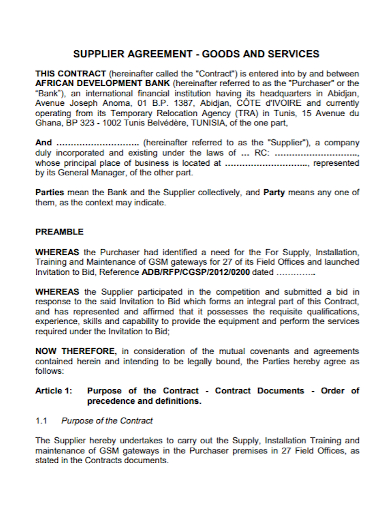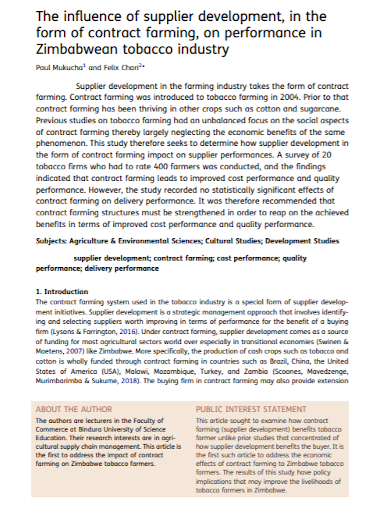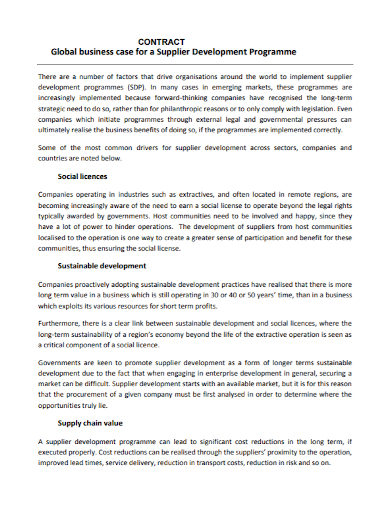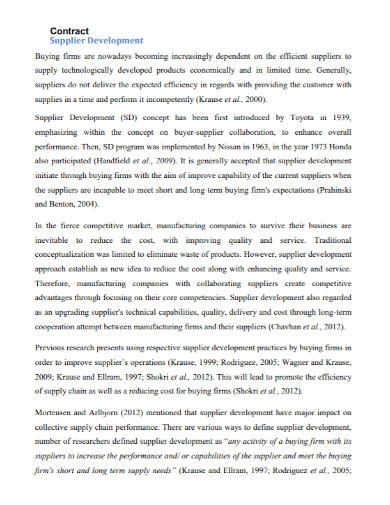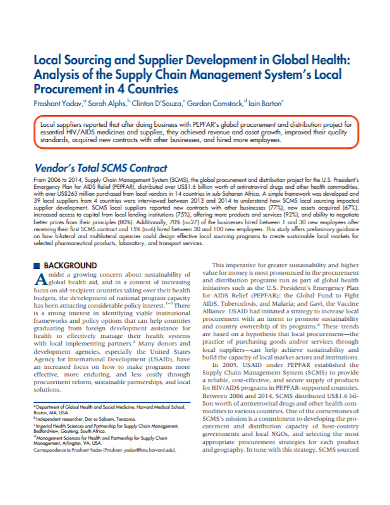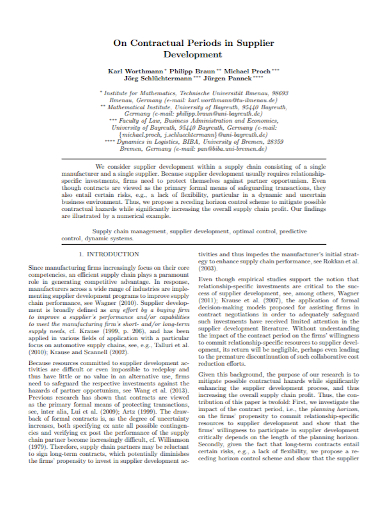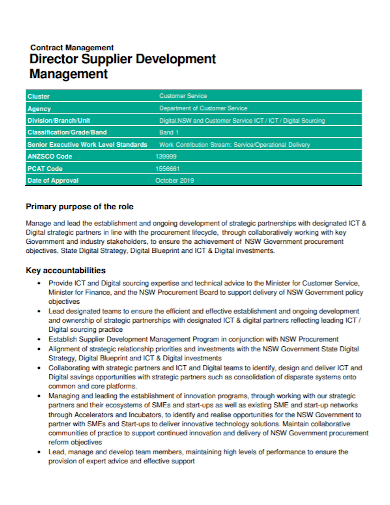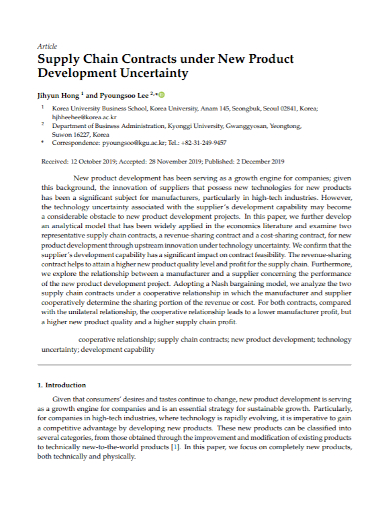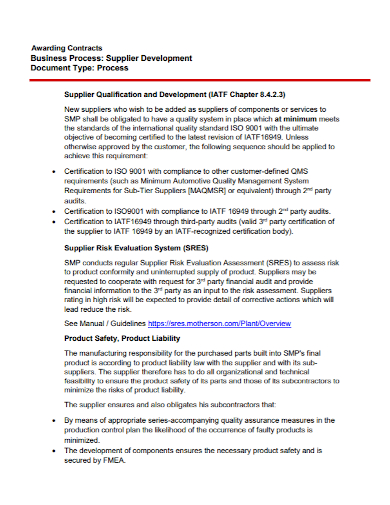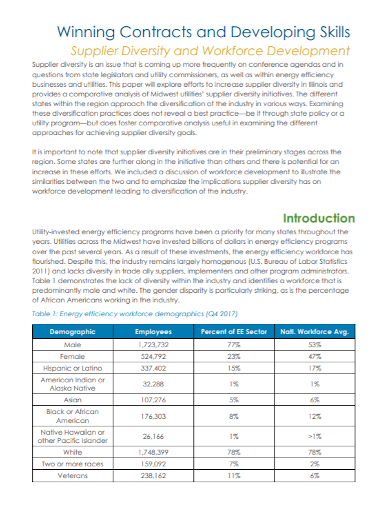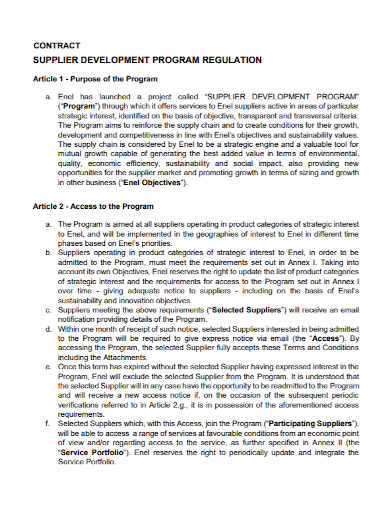Businesses are expected to change faster in an increasingly dynamic marketplace, and many of these innovations come from suppliers. Few, on the other hand, have mastered the art of developing suppliers to boost business competitiveness. It is the goal of supplier development to develop a new capability or competency in suppliers. It is frequently associated with, but distinct from, performance improvement. Organizations can gain a competitive advantage by developing their suppliers. This can take the form of a new product for sale, a more efficient process, or the adoption of a new standard.
10+ Supplier Development Contract Samples
Suppliers are a huge – and often underutilized – the source of innovation, continuous improvement, and cost savings. Companies can have a huge impact on the bottom line by enabling this potential. Suppliers, on the other hand, are often hesitant to commit resources to a single buyer. They are concerned that their intellectual property will be misused and their cost models will be exposed, leaving the supplier vulnerable in future negotiations. In short, suppliers do not have faith in their customers.
1. Supplier Development Service Contract
2. Supplier Performance Development Contract
3. Supplier Business Development Contract
4. Supplier Development Contract
5. Vendor Supplier Development Contract
6. Sample Supplier Development Contract
7. Supplier Development Management Contract
8. Supplier Chain Development Contract
9. Supplier System Development Contract
10. Supplier Workforce Development Contract
11. Supplier Development Program Contract
Levers to Build Trust and Develop Supplies
- Communication – Simply directing is the simplest way to up-skill suppliers. This is partly determined by the relative strength of the buyer company. You can’t force a supplier to invest in new technologies if they don’t want to or if they don’t think you’ll lose money if you cancel the contract. Supplier communication can be facilitated in bulk via generic emails or a supplier portal, but these are unlikely to result in significant changes. Change is more likely to be sparked by tailored communication from supplier managers to account managers. The easier it is for suppliers to follow the expectations (with dated milestones and measurable deliverables), the better.
- Training – There are two types of training. For starters, remote training enables buyers to use on-demand webinars to communicate new standards or systems. Because travel is kept to a minimum, this consumes significantly fewer resources for both the buyer and the supplier, but the impact of such sessions can be questionable. Classroom-based learning is a second more direct method of education. On-site sessions allow for easy interaction between the buyer and the supplier, allowing for clear communication and the development of a supplier development plan. These trainings are frequently outsourced to third-party providers. When it comes to new capabilities in corporate social responsibility or complying with a new law, lawyers’ training abilities can be a way to ensure compliance.
- On-site assistance – On-site assistance can help you quickly implement a new capability, whether it’s a new technology or a new management practice, and it can save you time compared to sourcing from a new supplier. Indeed, where your company has the know-how, the supplier can save money on management consulting, which can be passed on to your company. The on-site staff can also ensure that all developments adhere to the policies and standards of the purchasing company.
FAQs
What is the purpose for embarking on supplier development?
• improving the performance of suppliers
• lowering costs
• addressing critical quality issues
• establishing new supply routes
• improving the supplier’s and customer’s business alignment
• creating a product or service that isn’t currently available in the market
the open market
• causing a high-priced product or service to face competition
monopolizing the market
What might supplier development involve?
Embracing supplier expertise is an important part of supplier development. and matching it to the needs of the buying organization and, when necessary, vice versa. The goals of the Minor development, such as a smidgeon of hair growth, are possible. alterations in staffing levels or very significant changes, such as the An entire range of critical products was evaluated and re-launched.
The final of the three items is the most effective way to show the supplier that your company is committed to a long-term and fruitful partnership. The perception of buyer commitment is the main impediment to supplier trust. The more she can demonstrate that the buyer has invested in the relationship – through evidence, not emails – the more trust the supplier will have in her. Once this trust has been established, supplier development can provide significant value to the purchasing organization.
Related Posts
FREE 14+ Sample Music Concert Proposal Templates in MS Word | Google Docs | Pages | PDF
FREE 10+ Security Guard Contract Samples in PDF | MS Word
FREE 10+ Assurance Agreement Samples In MS Word | Google Docs | Apple Pages | PDF
FREE 10+ Option to Purchase Agreement Samples in MS Word | Apple Pages | PDF
FREE 26+ Curriculum Form Samples in MS Word | PDF
FREE 20+ Cleaning Service Proposal Samples in PDF | MS Word
FREE 29+ Sample Loan Application Form Templates in MS Word | PDF
FREE 10+ Event Venue Contract Samples in PDF | MS Word | Pages | Google Docs
FREE 10+ SBAR Samples in PDF | DOC
FREE 12+ Music Band Contract Templates in PDF | MS Word
FREE 10+ HVAC Maintenance Contract Samples in PDF | MS Word
FREE 10+ Social Media Marketing Contract Samples in MS Word | PDF
FREE 10+ Wholesale Assignment Contract Samples in PDF
FREE 18+ Financial Proposal Samples in PDF | MS Word | Google Docs | Pages
FREE 10+ Feasibility Study Samples in PDF

